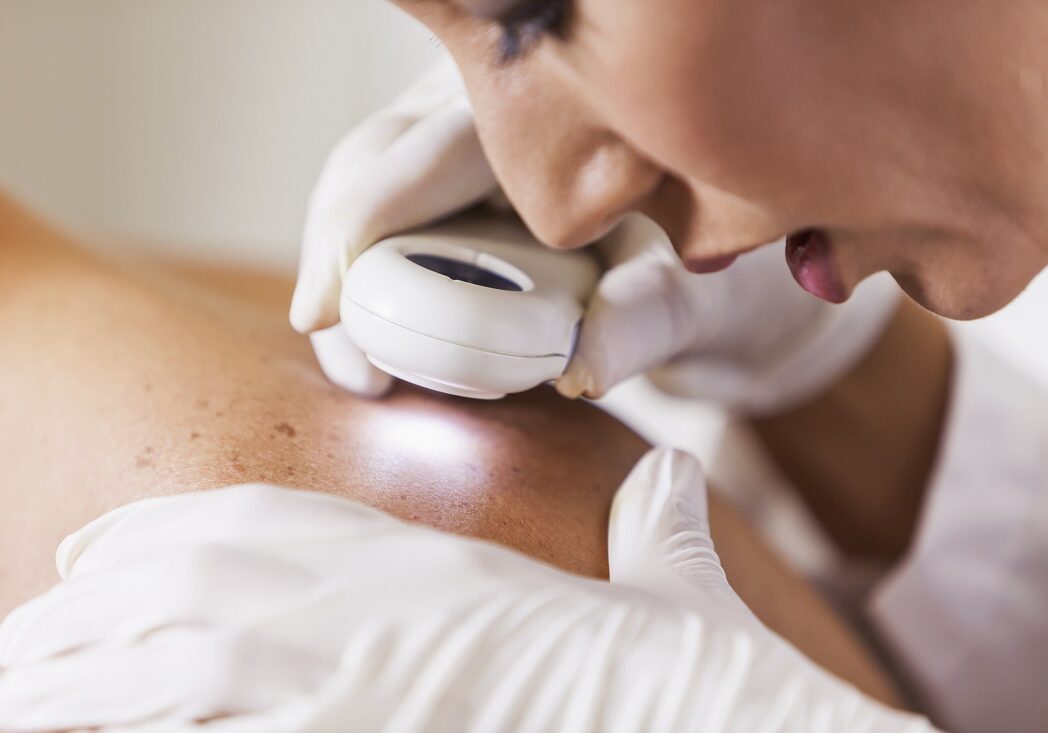Skin cancer awareness month
There are numerous “Awareness” months, dedicated to raising our awareness of important issues. For example, January is National Blood Donor Month, and February is American Heart Month. March is National Kidney Month and of course, October is Breast Cancer Awareness Month. Some months share their time with other causes, for example January is also known in England as “Veganuary,” which is near and dear to my own stomach. Each month aims to educate, advocate, and support individuals and communities affected by the respective issues or causes. But to a Dermatologist, one of the most important months is May, which is Skin Cancer Awareness Month! Never mind that we share May with Lyme Disease Awareness Month, Mental Health Awareness Month, and, one of my favorites, National Pet Month. Because here at OnSpot Dermatology, during the month of May we’re all about shedding light on skin cancer!

Skin cancer is the most common type of cancer in the United States. According to the American Academy of Dermatology, it’s estimated that every day about 9,500 people in the United States are diagnosed with skin cancer. There are many different types of skin cancer, of varying levels of danger, but most are in some way related to excessive sun exposure. Many skin cancers could be prevented if people would protect their skin from the sun and stop using tanning beds.
There are some important things about skin cancer that many people aren’t aware of. People of all colors, races, complexions and ages get skin cancer. When found early, most skin cancers are highly treatable. Many skin cancers are actually found by the patients, so self-skin examinations are very effective! When someone finds an unusual spot on their own skin, a trip to the Dermatologist can be lifesaving. No matter a person’s skin tone, dermatologists encourage checking your own skin for signs of skin cancer.
May ushers in the beginning of the “sun season,” not just in Florida, but across the country. Spring and summer are full of outdoor activities. You probably put sunscreen on yourself and your kids when you go to the pool or the beach. But do you know you should protect your skin with more than just sunscreen anytime you’re outside? At OnSpot Dermatology, in addition to recommending self-skin examinations, we encourage everyone to “Practice Safe Sun.” This involves three simple steps to reduce the chances of skin cancer:
- Seek shade
- Wear sun protective clothing
- Apply sunscreen that offers broad-spectrum protection, water resistance, and an SPF of 30 or higher
When you go outside during this season, what’s in your tote bag? Here’s a tip to help make sure you and your family stay sun-safe: pre-pack a bag with a lightweight long-sleeved shirt or cover-up, and a hat with a wide brim to shade your face, ears and neck. Add sunglasses and sunscreen and you’re all set for summer! Just grab the tote bag and go have fun!
Since May marks Skin Cancer Awareness Month, it’s a great time to dedicate to educating ourselves about the risks, prevention, and early detection of this potentially life-threatening disease. And it’s a great time to remind ourselves about the significance of regular skin screenings, performed by trained professionals. So here’s a synopsis of the most important aspects of skin cancer:
Understanding skin cancer
Skin cancer is the abnormal growth of skin cells, typically triggered by DNA damage from ultraviolet (UV) radiation exposure. There are three main types of skin cancer: basal cell carcinoma (BCC), squamous cell carcinoma (SCC), and melanoma. BCC and SCC are the most common types, typically developing on sun-exposed areas of the body, such as the face, neck, hands, and arms. Melanoma, although less common, is one of the most dangerous types, as it can spread rapidly to other parts of the body if not detected early.
Causes and risk factors
Excessive exposure to UV radiation, whether from sunlight or tanning beds, is the primary cause of skin cancer. However, several risk factors can increase an individual's susceptibility to developing the disease. These include:
- Fair skin: People with fair skin, light hair, and light-colored eyes are at higher risk because they have less melanin, which provides some protection against UV radiation
- History of sunburns: A history of severe sunburns, especially during childhood, can significantly increase the risk of developing skin cancer later in life
- Family history: Individuals with a family history of skin cancer are at greater risk, indicating a genetic predisposition
- Weakened immune system: Immunosuppressive conditions or medications can compromise the body's ability to fight off cancerous cells
- Excessive sun exposure: Spending long hours in the sun without adequate protection, such as sunscreen and protective clothing, increases the risk of skin cancer
Prevention strategies
As mentioned above, most of the prevention strategies involve protecting against harmful UV rays (Sun exposure). It is well-accepted that limiting exposure to the sun, especially during peak hours (10 a.m. to 4 p.m.), and seeking shade whenever possible can help minimize UV radiation exposure. Sunscreen and protective clothing are also very helpful. And it’s also important to avoid tanning beds, since these can dramatically increase the chances of developing skin cancers. In addition, regular skin checks are one of the most effective ways of having skin cancer detected early. This includes performing monthly self-examinations in front of full length mirror, looking for any changes in moles or freckles, or any other skin abnormalities. And regular examinations by professionals that are skilled at looking for skin cancers are recommended. At OnSpot Dermatology, the providers are specifically trained to perform thorough skin examinations, and detect even the most subtle abnormalities.
Importance of early detection
Early detection is the key to successfully treating skin cancer and preventing its spread. The ABCDE rule can serve as a useful guide for identifying potential signs of skin cancer. This is applies to spots you may find on your skin, and any changes in these features might be important:
- A - Asymmetry: One half of the mole does not match the other half
- B - Border irregularity: The edges of the mole or spot are uneven, notched, or blurred
- C - Color variation: The spot has multiple colors or uneven distribution of color
- D - Diameter: The spot has enlarged compared to how it was previously. And in general, pigmented moles bigger than an pencil eraser should be checked out
- E - Evolution: The spot has been changing over time, including size, shape, color or texture
If you notice any of these warning signs, it’s important to consult a trained professional for further evaluation.
Final thoughts
I’m reminded of a fun and true anecdote. I was in Australia several years ago, and although I don’t know if they actually have a “Skin Cancer Awareness Month,” they are acutely aware of sun protection techniques. This is because there is a high incidence of skin cancer in Australia. I was impressed with their slogan, “Slip, Slop, and Slap!” which has been one of their most successful health campaigns over the last 40 years. It refers to Slip on a shirt, Slop on some sunscreen, and Slap on a hat. In fact, they had a cartoon mascot, Sid the Seagull, who tap-danced across their TV sets singing a jingle reminding people about it! Since then, they have added two more parts: “Seek” (shade) and “Slide” (on a pair of sunglasses). Maybe we should all remember Sid the Seagull, and Slip, Slop, Slap, Seek and Slide!
Skin Cancer Awareness Month serves as a reminder of the importance of prioritizing skin health and taking proactive measures to prevent and detect skin cancer. By understanding the risk factors, practicing sun-safe behaviors, and prioritizing regular skin checks, we can significantly reduce our risk of developing this potentially life-threatening disease. Education and awareness are powerful tools in the fight against skin cancer, and emphasizing Skin Cancer Awareness Month can help us spread knowledge and promote healthy habits. We can work together to protect ourselves and our loved ones from the harmful effects of skin cancer. Let us use this month as an opportunity to shine a light on skin cancer and empower ourselves to take control of our skin health for a brighter, cancer-free future.

About the author
Jay Herbst, MD
Dr. Jay Herbst attended medical school at the University of Miami, and then completed two full residency training programs. He completed both Internal Medicine and Dermatology residencies at the University of Miami-affiliated hospitals and Mount Sinai Medical Center, and is Board-Certified in both specialties. He is recognized throughout the country as an outstanding academician, researcher, teacher, and practitioner. He has published over 40 medical journal articles and textbook chapters, and has lectured extensively at medical conferences. Dr. Herbst is a Fellow of the American Academy of Dermatology, and is a member of the American Society for Mohs Surgery, Florida Society of Dermatology and Dermatologic Surgery, American Medical Association, and the Florida Medical Association.
MEDICAL ADVICE DISCLAIMER
The information provided on this site is for educational and informational purposes only. It is not intended to be a substitute for professional medical advice, diagnosis, or treatment. Always seek the advice of your physician or other qualified health provider with any questions you may have regarding a medical condition. OnSpot Dermatology is not providing personalized medical assessments or recommendations for individual cases in this post. The content presented here is based on general knowledge and should not be considered a substitute for a consultation with a qualified healthcare professional. The use of information provided is solely at your own risk. OnSpot Dermatology and the author make no representations or warranties, express or implied, regarding the completeness, accuracy, or usefulness of the information presented. By reading this post, you agree to the above disclaimer and understand that any action you take based on the information provided is at your own discretion. If you have specific questions or concerns about your skin or any medical condition, please consult a healthcare professional for a personalized assessment and recommendations.
